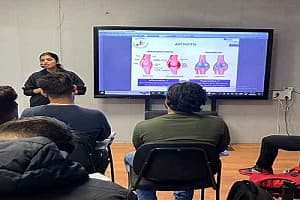Calcium and Vitamin D: Introduction, Sources, and Health Benefits

Dr. Chirag Sethi* and Dr. Swarna Anchal**
*Director, Classic Fitness Academy
**Technical Writer, Classic Fitness Academy
Introduction
Calcium word comes from the Latin word 'cals’ and we need calcium for bone and teeth health. Out of a total value (100%), bones and teeth having 99% of body calcium, 0.9% in the cells, and 0.1% circulate in our blood. Blood calcium level is regulated by the body as per the need. Apart from this, it is also necessary for healthy communication between brain and body parts, muscular contractions, and cardiovascular function. To avoid calcium deficiency, its level must be optimum in the body; our diet is calcium-rich, and its metabolism and absorption are proper in the body.
On the other hand, alongside calcium, vitamin D is also required as it helps in the absorption of calcium. In humans, the most important groups are vitamin D3 (cholecalciferol) and vitamin D2 (ergocalciferol). Vitamin D is synthesized in the skin in presence of sunlight but high melatonin present in skin halt its production. However, in the present age of urbanization and sedentary lifestyles, we may not get the required daily sunlight exposure.
This article providing information regarding the need for calcium, foods that are rich in calcium and vitamin D, what happens if their level drops beyond the optimum, and its supplements.
Recommended Daily Allowance (RDA)
According to the Office of Dietary Supplements (ODS), the following table shows the amounts of calcium and vitamin D that are recommended on daily basis. A doctor may recommend additional calcium for people with a deficiency in calcium and vitamin D level such as females who have started menopause, stop menstruating due to eating disorders, people having lactose intolerance or a cow’s milk allergy, and follow a vegan diet.
Calcium occurs naturally in many foods and people can obtain calcium from a range of foods and drinks.The following table shows the sourcesof calcium:
Why We Need Calcium and Vitamin D
(1) Bone health
As we have read above that 99% of the calcium is in the bones and teeth and essential for their development, growth, and maintenance and vitamin D helps the body to absorb calcium. At a growing age, children need calcium that contributes to the development of their bones and calcium continues to help maintain the bones and slow down bone density loss when we stop growing. It is a natural aging process. Females who have reached menopause can lose bone density at a higher rate than males as they have a higher risk for osteoporosis and may be recommended calcium supplements by the doctor.
(2) Muscle contraction
Calcium helps in the regulation of muscle contraction. When stimulation comes to a muscle, the body releases calcium. This released calcium binds to the proteins in the muscle to carry out the muscle contraction. The muscle will relax when the body pumps the calcium out of the muscle.
(3) Cardiovascular system
Calcium plays an important role in maintaining the action of the heart muscle as it relaxes the smooth muscle that surrounds blood vessels and lowers blood pressure.
Another significant role of calcium is in blood clotting. The clotting process is very complex and has several steps. These steps involve a range of chemicals, including calcium which ultimately helps in blood clotting.
(4) Other roles
Calcium works synergistically with many enzymes and acts as a co-factor for them. Without calcium, some key enzymes cannot work efficiently and the process will not be completed.
Many researchers have shown that consuming enough calcium may have health benefits:
- Lowers the high blood pressure during pregnancy
- Lower blood pressure in young people
- Improve cholesterol level in the blood
- Lowers the risk of colon cancer
- Prevent Hair loss
Calcium Deficiency
The deficiency of calcium is known as ‘Hypokalemia’ and it can disturb a normal lifestyle and sometimes may lead to severe conditions. Here is a list containing some points that can lead to its deficiency. More or less our body eliminates some calcium in sweat, urine, and feces and some foods and activities also encourage these functions which may reduce the levels of calcium in the body.
Calcium supplements
Supplementation is generally required when there is not enough calcium in the diet and the daily required value is not fulfilled. They are given orally and intravenously to treat low blood calcium, osteoporosis, and rickets. A doctor may recommend calcium supplements when they found a deficiency of calcium in a person. People, who use calcium supplements should check first with their doctor, follow the dosage as recommends by the doctor, take the supplement with food for best absorption, and consume the other supplements by keeping time intervals between them. Many calcium supplements also contain vitamin D which helps the body to absorb calcium efficiently.
Types of supplement
There are different types of supplements and recommendations will depend on the individual’s needs and any other medications they are taking due to medical conditions.
Inactive forms of calcium supplements can be converted by the body to an active form. They are cheap and nontoxic too as there are no other issues associated with them such as overdose.
Active forms are those which are recommended to some medical patients (under the supervision of doctors) with impaired liver and kidney function and they are costly than other forms.
Other forms are:
There is no doubt that some side effects are associated with high calcium intake such as thyroid problems, a higher risk of heart attack, kidney problems, reduction in iron absorption, and impaired bowel movements such as constipation. Although try to avoid taking them with antibiotics and if someone is taking calcium channel blocker medications to lower blood pressure.
Conclusion
Calcium is essential for healthy bones and teeth and also helps in managing blood pressure. The best sources for calcium intake are dairy products, green leafy vegetables, beans, fermented products, and fruits.
However, there is a myth associated with calcium intake that leads to kidney stones. But ‘Oxalate’ is the main component of kidney stones and calcium helps to lower the level of oxalate in blood and prevents them to congregate in the kidney. So there is no such problem associated with calcium intake but supplementation is required for some people who have calcium deficiency and he/she should ask their doctors for advice.
References:
(1) Stuart MC, Kouimtzi M, Hill SR (2009). World Health Organization: 497.
(2) British national formulary: BNF 69 (2015). British Medical Association: 694-703.
(3) Richart H (2015). Tarascon Pocket Pharmacopoeia. Jones & Bartlett Learning: 215–216.
(4) Wolfgang TF (2012). Calcium Carbonate: From the Cretaceous Period into the 21st Century. Birkhauser: 308.
(5) Calcium; Cholecalciferol-Drug Usage Statistics" (2020) Clinical Calculations.
(6) Reid IR, Bristow SM, Bolland MJ (2015). Calcium supplements: benefits and risks. Journal of Internal Medicine 278(4): 354–68.
(7) Virginia AM (2013). Vitamin D and calcium supplementation to prevent fractures in adults: U.S. Preventive Services Task Force recommendation statement. Annals of Internal Medicine 158(9): 691–696.
(8) Calcium and Cancer Prevention: Strengths and Limits of the Evidence (2009). National Cancer Institute.
(9) Beall DP, Henslee HB, Webb HR, Scofield RH (2006). Milk-alkali syndrome: a historical review and description of the modern version of the syndrome. American Journal of Medicinal Science 331(5): 233–42.
(10) Calcium salts (2017). The American Society of Health-System Pharmacists.
(11) Straub DA (2007). Calcium Supplementation in Clinical Practice: A Review of Forms, Doses, and Indications. Nutrition in Clinical Practice 22(3): 286–96.
(12) Martin BR, Weaver CM, Heaney RP, Packard PT, Smith DL (2002). Calcium Absorption from Three Salts and CaSO4-Fortified Bread in Premenopausal Women. Journal of Agricultural and Food Chemistry 50(13): 3874–6.
(13) Balk EM, Adam GP, Langberg VN, Earley A, Clark P, Ebeling PR, Mithal A, Rizzoli R, Zerbini CAF, Pierroz DD, Dawson-Hughes B (2017)Global dietary calcium intake among adults: a systematic review. Osteoporosis International 28(12): 3315–3324.






